- Surging Stock Price: Recursion Pharmaceuticals (NASDAQ: RXRX) spiked over 16% in early trading on October 20, 2025, reaching around $6.8 per share intraday [1]. This jump follows a volatile month in which RXRX plunged to the mid-$5 range then rebounded sharply (~16% gain on Oct 8) after an AI-focused tech conference and pipeline news [2]. Despite the rally, the stock remains ~37% below its 52-week high of $10.87 [3].
- Recent Volatility: Over the past month, Recursion’s share price has skyrocketed +44%, vastly outperforming the biotech sector’s ~3% gain and the S&P 500’s ~0.9% uptick [4]. Heavy trading volume accompanied the swings – e.g. ~86.9 million shares traded on Oct 16 (over 200% of normal volume) amid renewed interest in AI drug discovery [5] [6].
- Insider Sale Raises Eyebrows: CEO Chris Gibson sold 100,000 shares on Oct 10 (~9.5% of his direct holdings) at an average ~$6.04 for ~$604,000 [7]. The stock dipped to $5.53 by Oct 13, post-sale [8]. Motley Fool analysts noted the sale “isn’t a great sign of confidence” [9], though it aligns with Gibson’s prior planned trades. The CEO’s selling, coupled with dilution (shares outstanding up 52% in the past year to 436.5M [10]), underscores investor caution as the company continues to operate at a loss.
- Financial Snapshot: Recursion’s last quarterly report (Q2 2025) showed revenue $19.2M (+33% YoY, boosted by a $7M Sanofi milestone) but a net loss of $171.9M [11]. Cash on hand was $534M (runway into late 2027) [12] after heavy R&D investments (including its merger integration). Upcoming Q3 2025 earnings are expected to show a -$0.35 EPS loss on ~$17.5M revenue (–33% YoY) [13]. Full-year 2025 revenue is forecast around $72.4M (+23% YoY) [14] with a net loss of ~$1.50 per share.
- Partnerships & Merger Momentum: Recursion has built an extensive web of big-pharma collaborations. Active deals include Sanofi (multi-target oncology/immunology, $130M+ in upfronts/milestones so far) [15], Roche/Genentech (AI-driven neuroscience and oncology programs), Bayer, Takeda, and Merck KGaA on various drug discovery projects [16]. In late 2024, Recursion acquired UK-based Exscientia in an all-stock merger (~$630M value) to bolster its AI platform [17]. The combined company now boasts 10+ clinical and preclinical programs, has received $450M in partner payments to date with over $20B in potential future milestones, and employs about 800 staff across its Salt Lake City HQ and global offices [18].
- Pipeline Focus: The biotech’s R&D centers on oncology and rare genetic diseases. Lead in-house candidates include REC-1245 (an oral RBM39 protein degrader for solid tumors) and REC-617 (a CDK7 inhibitor for ovarian cancer), both currently in Phase 1/2 trials [19]. New additions from partnerships include REC-102 (ENPP1 inhibitor for a bone disorder, licensed in mid-2025) and REC-4881 (MEK inhibitor for familial adenomatous polyposis) [20]. Several lower-priority programs were shelved in 2025 to conserve resources for these key assets [21]. Notably, Phase 2 data readouts for REC-4881 and REC-617 are anticipated by late 2025 [22] – critical inflection points for the company.
- Analyst & Sector Outlook: Wall Street sentiment on RXRX is mixed. The stock carries 2 Buy, 6 Hold, 1 Sell ratings with an average price target around $6.50–$7.00 (roughly 10–20% above recent prices) [23] [24]. Needham recently reiterated a Buy with an $8 target, applauding Recursion’s “leadership in AI-driven drug discovery” and massive proprietary data advantage [25]. However, value-oriented firms are wary: Zacks Investment Research gives RXRX a Rank #4 (Sell) due to ongoing losses and downward earnings revisions [26]. CNBC’s Jim Cramer went so far as to quip that Recursion has “done absolutely nothing” yet and must prove its platform with actual clinical success [27]. Overall, analysts see high-risk, high-reward, with upside if AI-derived drugs deliver – and downside if the hype isn’t met with real results.
Stock Soars on Oct 20 Amid Wild October Trading
Recursion’s stock is on a rollercoaster ride this month. Early on October 20, RXRX surged ~16–18%, hitting intraday highs near $6.8 [28]. The rally comes after shares slid 7.9% on Friday to $5.86 [29], as traders took profits following a mid-October run-up. Broader market tailwinds helped – the Nasdaq Composite was up ~1% on Monday – and several biotech peers also soared on news (for example, Replimune jumped 100%+ on an FDA decision, and Celcuity climbed 46% on trial data) [30]. Recursion’s sharp rebound Monday recoups some losses from last week’s pullback and underscores the extreme volatility surrounding this AI-driven biotech.
Recursion is often dubbed a “TechBio” biotech – a company at the nexus of high tech and biology. Pictured: Recursion’s Salt Lake City headquarters. Founded in 2013, the firm has scaled up via partnerships and acquisitions (merging with Exscientia in 2024) to around 800 employees today [31]. It leverages automation, massive datasets, and machine learning – what it calls the “Recursion OS” platform – to industrialize drug discovery [32]. The company claims this approach can compress timelines from idea to clinical trial to ~18 months, versus ~3–4 years traditionally [33]. Investors have been captivated by Recursion’s AI potential, but the stock’s recent swings show sentiment can turn on a dime with any news or even speculation.
Earlier this month, RXRX illustrated that volatility. On Oct 7, the stock fell ~5.4% to about $5.23 amid a broader market selloff [34]. The very next day (Oct 8), it skyrocketed ~16% to ~$6.08 [35], after CEO Chris Gibson delivered a keynote at a major AI conference in Dubai. Hype around Recursion’s AI breakthroughs and partnership news ignited a flurry of buying [36] [37]. Momentum continued into mid-October: by Oct 15, shares hit an intraday peak around $6.79, roughly a one-month high. However, on Oct 16–17 the stock stumbled (dropping from $6.36 to $5.86) as some traders locked in gains [38] and a lack of immediate follow-up news tempered the rally. Even with October’s wild swings, Recursion is up ~44% over the past month and about flat year-to-date, showing both the promise and the turbulence of an early-stage biotech riding the AI wave [39].
Notably, trading volumes have surged alongside price moves. On Oct 16, more than 86 million RXRX shares changed hands – over triple the typical daily volume [40] [41] – indicating heightened interest (or short covering) as investors repositioned ahead of potential news. Technical indicators show the stock’s 50-day moving average (~$5.10) remains below its 200-day (~$5.80), suggesting the recent jump has not yet pushed RXRX into “overbought” territory [42]. Still, at around $6–7, the share price sits in the middle of its 52-week range ($3.97–$10.87) [43]. For long-term holders, Recursion’s valuation has seesawed but remains well under last year’s highs – a sign that the market is eager for concrete results to justify sustained upside.
Business Updates: Pharma Alliances, Pipeline Progress, and M&A
Recursion’s business model centers on pairing its AI drug discovery platform with the resources of larger pharma partners. These partnerships both fund Recursion’s research and validate its approach. To date, the company has inked multiple high-profile alliances:
- Sanofi – a multi-program deal in oncology and immunology. Sanofi has paid Recursion over $130 million so far in upfront fees and milestones [44], including a $7M milestone payment logged in Q2 2025 [45]. This partnership is exploring several targets, reflecting Sanofi’s bet on Recursion’s AI to deliver new drug candidates in cancer/immunology.
- Roche/Genentech – focusing on using Recursion’s phenomics platform for neuroscience and gastrointestinal oncology drug discovery [46]. Roche’s involvement (through its Genentech unit) gives Recursion a foothold in neurology, one of biotech’s toughest arenas, by applying AI to image-based cell biology at scale.
- Bayer – a collaboration aimed at finding treatments for fibrotic diseases and precision oncology, leveraging Recursion’s data to go after “undruggable” targets [47]. Bayer’s interest aligns with its push into AI-driven R&D in recent years.
- Takeda – a partnership on undisclosed targets (reportedly in rare diseases/cancer), which taps Recursion’s platform alongside Takeda’s clinical development muscle [48].
- Merck KGaA – focusing on cancer and immunology programs, similar to the Sanofi collaboration, providing Recursion with both funding and a potential path to late-stage development via Merck’s pipeline [49].
These deals have already brought in ~$450 million in upfront and early milestone payments to Recursion [50]. More importantly, they include downstream milestone potentials exceeding $20 billion (if numerous programs hit success benchmarks) [51] – a testament to the large stakes if Recursion’s discoveries pan out. While those eye-popping milestone totals are not guaranteed (many depend on clinical progress that is years away), they highlight Big Pharma’s confidence in Recursion’s technology. As TechStock² observed, “without an FDA-approved drug, the company’s narrative relies on its AI platform and partnerships” [52]. In essence, Recursion’s collaborators help validate its platform in the absence of product revenue.
Another pillar of Recursion’s strategy has been strategic acquisitions to enhance its capabilities. The most significant was the late-2024 merger with Exscientia, a UK-based AI drug discovery firm. Completed in November 2024, this all-stock deal made Exscientia a wholly-owned subsidiary of Recursion [53]. The combination created an AI drug discovery powerhouse with more than 10 clinical and preclinical programs in the pipeline and 10+ partnered programs with pharma companies [54]. Exscientia’s strength in AI-driven molecular design is now integrated with Recursion’s 60 petabyte-scale biological dataset [55] [56], creating a synergistic platform that spans from target discovery to chemistry. The merged entity has roughly 800 employees and a presence across North America and Europe, though it remains headquartered in Salt Lake City [57]. Crucially, the Exscientia deal brought over several clinical-stage drug candidates (e.g. Exscientia’s novel precision oncology compounds) and added two Exscientia board members to Recursion’s board, signaling a deep melding of the companies’ visions.
“The merged platform integrates Exscientia’s chemical design methods with Recursion’s proprietary data… demonstrating the ability to find novel insights and dramatically reduce the time and cost of discovery,” the company stated when announcing the combination [58] [59].
Alongside partnerships and M&A, pipeline prioritization has been a key theme in 2025. Recursion’s R&D leadership made tough calls to trim less promising programs and double down on lead assets. In mid-2025, the company announced it would cut ~20% of its workforce to streamline operations and “reduce complexity” in its portfolio [60]. As CEO Gibson put it, the goal was to ensure each dollar “drives real return on investment” in R&D [61]. Resources have been reallocated toward the most advanced or novel candidates:
- REC-1245: a first-in-class RBM39 degrader, taken orally, aimed at treating solid tumors. This molecule emerged from Recursion’s AI screening of compounds that degrade RNA splicing factors. It entered Phase 1 trials in 2025 for advanced solid tumors, and management has highlighted it as a potential breakthrough if early efficacy signals appear [62]. “REC-1245, our potential first-in-class RBM39 degrader, [is showing] strong activity in preclinical models,” noted Chief R&D Officer Najat Khan on the Q2 earnings call [63].
- REC-617: a CDK7 inhibitor for ovarian cancer (and possibly other solid tumors). CDK7 is a cell cycle regulator; inhibiting it can trigger cancer cell death. REC-617 (acquired from Exscientia’s pipeline) is in Phase 1 testing as of 2025. Early data included at least one partial response in a treated patient – an encouraging sign, according to Khan, who said the team was “encouraged by a partial responder in REC-617” during early trials [64]. Further dose escalation data are expected soon.
- REC-4881: a MEK1/2 inhibitor being studied for familial adenomatous polyposis (FAP), a rare genetic condition that causes precancerous polyps. Recursion picked up REC-4881 in a portfolio acquisition from another biotech and repurposed it for FAP. It’s in a Phase 2 study now. Importantly, clinical data from this trial are due by end-of-year 2025 [65]. Investors consider this readout a critical test of Recursion’s ability to deliver results in an indication with no approved drugs (FAP can lead to colorectal cancer if untreated).
- REC-102: an ENPP1 inhibitor licensed in July 2025 for hypophosphatasia (a rare bone disorder) [66]. This program, still preclinical, shows Recursion’s willingness to bring in external candidates for diseases that fit its rare disease focus. If advanced, it would move Recursion into metabolic bone disease, diversifying its pipeline beyond oncology.
- Deprioritized programs: In contrast, Recursion shelved at least three programs in 2025 that were not meeting benchmarks. Notably, a once-lead candidate for cerebral cavernous malformation (REC-994) was dropped after an interim analysis, and certain fibrosis programs were paused [67] [68]. This was done to concentrate funding on the narrower set of high-potential drugs listed above. The company’s strategy now is clearly to get a few winners into late-stage trials rather than spread resources too thin across many early projects.
On the technology front, Recursion continues to burnish its AI credentials. In mid-2025, the company (with collaborators at MIT and NVIDIA) open-sourced “Boltz-2”, an advanced machine learning model for predicting how molecules bind to targets [69]. Boltz-2 can reportedly screen compounds ~1000× faster than traditional lab methods [70]. By sharing it openly, Recursion gained industry goodwill and affirmed its status as a leader in AI for chemistry. The firm is also using ultra-large datasets (over 60 petabytes of cellular imaging and genomic data) to train its proprietary algorithms – a scale few peers can match [71] [72]. Management frequently emphasizes that this combination of big data and big compute is Recursion’s moat. As CEO Gibson described, “The power of our platform [is that it] not only allows us to discover and develop potential new medicines, but also gives us insights on patient populations…” [73] – meaning Recursion’s data may help identify which patients would benefit most from a given drug, potentially streamlining clinical trials.
Financials and Recent Developments
Running an AI-driven drug discovery operation is expensive, and Recursion’s financial results reflect heavy investment mode. In Q2 2025, the company brought in $19.2 million in revenue [74], primarily from collaboration payments (there are no product sales yet, as Recursion has no approved drugs on the market). That top line was up +33% year-over-year, thanks largely to milestone payments like the $7M from Sanofi’s partnership [75]. It’s a positive sign that partners are hitting research milestones – essentially validating intermediate goals in Recursion-led projects. However, operating costs climbed even faster. R&D expenditures jumped to ~$128.6M in Q2 (up significantly year-on-year) [76], due in part to integrating Exscientia and purchasing external data (Recursion inked a data deal with Tempus in 2023, adding to costs [77]). The result was a net loss of $171.9M for the quarter [78], wider than the ~$126M loss a year earlier. In short, Recursion is spending over $10 for every $1 in revenue as it pushes its pipeline forward – a typical pattern for a clinical-stage biotech, but one that demands continual cash infusions.
On that front, the company’s balance sheet remains strong for now. As of June 30, 2025, Recursion held $533.8M in cash and equivalents [79]. CFO Vijay Mookerjee has stated this war chest should fund operations into late 2027 (roughly two more years beyond the expected end of 2025) [80]. Management even indicated they plan to reach a “break-even in runway” by Q4 2027 [81] – essentially aiming to have potential product revenue or major new partnership inflows by then to sustain the business. While four years of runway is relatively comfortable, continued high burn rates (over $600M in 2024 and targeting <$450M in 2025 after cost cuts [82]) mean Recursion likely won’t turn a profit for several years. The current consensus forecast for full-year 2025 is a loss of about -$1.50 per share on $72M revenue [83] [84]. Analysts see losses continuing through at least 2026, albeit narrowing if partnership revenues grow.
Investors are now looking ahead to Recursion’s Q3 2025 earnings, due to be reported in the coming weeks. According to Zacks, analysts expect a -$0.35 EPS loss for Q3 (slightly worse than the -$0.34 in Q3 2024) and revenue around $17.5M [85]. Notably, that revenue would be down -33% from the same quarter last year [86], perhaps because Q3 2024 included a one-time payment (such as a large upfront from a deal) that isn’t repeating. Any upside surprise on revenue (for instance, unexpected milestone payments or new collaboration fees) could be a catalyst for the stock, while a miss – or higher cash burn – might raise concern. Recursion’s ability to manage expenses after its June headcount reduction will also be under the microscope.
One recent development that drew market attention was the insider stock sale by CEO Chris Gibson. According to an SEC filing, Gibson sold 100,000 shares on October 10, 2025 at an average price of about $6.04 [87]. He simultaneously converted 120,000 Class B shares to Class A (the publicly traded class) to execute the sale, and gifted an additional 20,000 shares to an undisclosed party [88]. After the sale and gift, Gibson’s direct holdings were around 954,000 shares. Importantly, the timing was notable: the sale occurred just after the stock’s early October jump, and days later Recursion’s price slid to ~$5.53 (by Oct 13) [89], meaning the CEO sold near a short-term high. In context, Gibson has been a periodic seller; since May 2024 he’s executed 17 sell trades, often in 100k share increments [90]. But this particular trade was larger relative to his stake – about 9.5% of his holdings vs a median ~3.7% in prior sales [91]. As Motley Fool observed, at over 10% of his shares, it “isn’t a great sign of confidence” from the CEO [92]. That said, the selling doesn’t necessarily signal doom: Gibson’s sales have been fairly regular and could simply reflect personal diversification or Recursion’s generous stock-based compensation (as the Fool mused, he may expect the sold shares to “soon be replaced” by new grants) [93]. Investors generally don’t love to see insiders cashing out if a company is supposedly on the cusp of breakthroughs, so this development added some near-term pressure to RXRX until other news (like the Oct 20 rally) took over the narrative.
On the regulatory front, there haven’t been dramatic new approvals or denials for Recursion – most pipeline programs are in early trials. However, it’s worth noting a positive industry trend: regulators are growing more receptive to AI and in silico methods in drug development. The U.S. FDA, for example, has signaled support for reducing animal testing and using computer models to evaluate drugs [94]. In October 2024, Recursion touted that it received FDA clearance to begin a Phase 1 trial of an AI-discovered oncology drug (one of the first such IND approvals) [95]. Such developments show that agencies are open to innovation, which bodes well for Recursion’s ability to advance its AI-derived drug candidates through clinical testing without undue regulatory skepticism.
Looking ahead, the next major milestones for Recursion will be data readouts and deal updates rather than financial results alone. The company has guided that by late Q4 2025 it should have additional results from the Phase 2 study of REC-4881 (for FAP) and initial Phase 2 data for REC-617 [96]. Positive efficacy signals from either trial could be a game-changer – potentially triggering partnership expansions or even buyout interest from larger pharma companies if the data is strong. Conversely, lackluster results would reinforce critics’ view that Recursion’s AI hasn’t yet delivered tangible breakthroughs. The balance of cash vs. progress will be closely watched: Recursion will need to show tangible pipeline advancement before its cash runway diminishes significantly, to avoid needing dilutive stock offerings (something shareholders are sensitive to, given the big jump in share count over the past year [97]).
Stock Forecasts and Analyst Commentary
Opinions on Recursion’s prospects vary widely, reflecting the uncertainty inherent in a pre-revenue biotech. According to MarketBeat/TipRanks data, the consensus rating is lukewarm – no strong buy ratings, but a couple of Buys offset by a majority of Hold recommendations [98]. In total, 2 analysts rate RXRX a Buy, 6 a Hold, and 1 a Sell, as of mid-October [99]. The average 12-month price target is in the mid-$6 range (roughly where the stock trades now), indicating that Wall Street sees only modest upside unless new information changes the narrative [100].
Several analysts covering Recursion have recently updated their models. Notably, Needham & Co.’s Gil Blum remains one of the more bullish voices. In September 2025, Blum reiterated his Buy rating and $8 price target, arguing that Recursion is a leader in AI-enabled drug discovery with an unmatched store of biological data to feed its algorithms [101]. He believes this gives the company a structural advantage that could yield a pipeline of novel medicines, justifying a higher valuation if key programs progress. On the other hand, Morgan Stanley keeps an Equal-Weight (Hold) on RXRX with a much lower ~$5 price target, essentially suggesting the stock is fully valued around current levels until proof-of-concept is achieved in the clinic [102]. Bank of America is in between, reportedly a Hold with an $8 target (showing some optimism but not enough to rate it a Buy) [103]. The wide range of price targets – from about $3 on the low end to $10 on the high end [104] – underscores the debate: bulls see Recursion as an eventual big winner in a transformative field, while bears point to the long road (and cash burn) before any FDA approvals.
Independent stock watchers have also chimed in. A recent Directorstalk investor outlook piece highlighted that at a share price around $5.50 (in mid-Oct), Recursion had a market cap of ~$2.4B and an average analyst target of $6.47 – implying about 17% upside [105]. It noted the company’s impressive 33% revenue growth rate and strong partnerships, but also its negative -86% return on equity and lack of profitability [106] [107]. Those figures illustrate the classic biotech conundrum: high growth potential but high current losses. Valuation metrics like P/E or PEG ratio are not meaningful for Recursion (since earnings are negative), so investors focus on intangible factors – technology edge, partnership traction, and management’s execution – to gauge the stock’s worth.
From a quantitative perspective, Zacks Investment Research currently assigns Recursion a Rank #4 (Sell) in its ranking system [108]. This ranking is driven by recent downward revisions in earnings estimates and Recursion’s underperformance relative to some biotech peers on near-term metrics. Zacks notes that over the last month, the consensus EPS estimate for Recursion fell by ~1.9% [109], a sign that analysts slightly trimmed expectations (perhaps factoring in higher R&D spending or delayed revenue). Moreover, Recursion’s industry (biotech/pharma) is ranked in the top 35% by Zacks’ system, meaning the sector as a whole is moderately strong – so the Sell rank is more company-specific. In essence, Zacks’ model is wary of RXRX until it sees positive estimate momentum or actual earnings improvement, neither of which may occur until a drug reaches late trials or commercialization.
Qualitatively, expert commentators are divided on Recursion. On one side, proponents argue that Recursion is pioneering a new model of drug discovery that could dramatically improve R&D productivity. They point to the company’s growing trove of data, its unique mix of lab scientists and software engineers, and the endorsement (and funding) from top-tier pharma partners as evidence that Recursion is on the right track. The ARK Invest team, for instance, hailed the Recursion–Exscientia merger as “a visionary step forward in the AI-driven transformation of drug discovery,” suggesting the combined entity could accelerate the industry’s shift toward computational R&D [110]. If Recursion’s approach succeeds, it might not just create drugs but fundamentally change how drugs are created, which is why it attracts attention beyond its immediate financial results.
On the other side, skeptics say that we’ve seen similar hype before – and that “AI in biotech” remains unproven. CNBC’s Jim Cramer captured this skepticism with a blunt take: Recursion has “done absolutely nothing” as a public company so far, and “needs proof of concept via clinical data” before believers can truly justify the valuation [111]. Indeed, as of late 2025, Recursion has been public for over two years (it IPO’d in 2021) and has yet to produce a pivotal trial, let alone a marketed drug. The company’s lead programs are still in early-stage trials, where most drug candidates fail. Bears also highlight the rapid cash burn and dilution: in the past 12 months, Recursion’s outstanding shares jumped by over 100 million (a 52% increase) due to equity fundraising and the Exscientia deal [112]. This dilution means any eventual profits would be split among a much larger shareholder base. “With over 100 million new shares floating around, delivering a satisfying return to long-term shareholders will be a lot more challenging,” cautioned a Motley Fool analysis [113]. In other words, even if Recursion strikes pharma gold, the payoff per share might be less than early investors hoped, unless the company’s overall value grows commensurately.
Motley Fool’s takeaway: “It’s probably best to wait until after we see clinical data that suggests the company’s AI-powered drug discovery engine is more effective than its peers’ before taking a risk on this volatile stock.” [114]. This sentiment resonates with many biotech analysts: data is king. The upcoming Phase 2 results for REC-4881 and REC-617 will be the first real test if Recursion’s high-throughput, AI-guided methods can produce a drug that helps patients. Success in those trials could rapidly shift the narrative in Recursion’s favor (and perhaps spur a stock re-rating), whereas disappointment would reinforce the skeptics.
Broader Biotech Context
Recursion’s journey is unfolding at a time of cautious optimism in biotech. After a brutal bear market in 2022–2023 for biotech stocks, 2025 has seen pockets of recovery, especially for companies tied to exciting technologies like gene editing or AI-driven discovery. Small and mid-cap biotech indices have bounced in recent months, though volatility remains high. Recursion’s ability to far outpace the market in a short period (44% in a month) [115] and then just as quickly give back gains is emblematic of the risk-on, risk-off swings in the sector. Investors are quick to chase promising news (as seen with Recursion’s AI buzz rally) but also quick to sell on uncertainty.
Within the “AI drug discovery” niche, Recursion is now one of the largest players thanks to the Exscientia merger. It competes (or partners) with a cadre of startups and tech-oriented pharma initiatives all aiming to algorithmically identify new therapeutics. Companies like Insilico Medicine, BioXcel, Schrodinger, and BenevolentAI are its contemporaries, each using slightly different AI techniques. The broader biotech industry is watching these AI-driven firms closely: if even one can deliver a blockbuster drug faster or cheaper by leveraging AI, it could trigger a paradigm shift – and possibly a scramble by pharma to acquire the winners. Recursion’s big pharma partners (and shareholders like NVIDIA, which invested $50M in Recursion in 2023) suggest that the pharma and tech sectors are already converging in this space [116]. That context provides both opportunity and pressure for Recursion. Opportunity, because success could lead to lucrative licensing deals or an acquisition by a deep-pocketed pharma giant flush with cash. Pressure, because multiple teams are in the race, and skepticism will remain until clear clinical wins emerge.
Meanwhile, macroeconomic factors such as interest rates and funding environments indirectly affect Recursion. In a higher-rate environment, unprofitable biotechs like Recursion face more scrutiny as investors demand a clearer path to profitability. Recursion’s stock, down about 20–30% from 2024 levels before the recent rally [117], had been reflecting those concerns. However, the company’s strong cash position insulates it from needing to raise money in the immediate term, which is a major advantage over cash-strapped peers. If biotech indices continue to recover and risk appetite increases, Recursion could benefit from a rising tide – especially given its alignment with the hot AI theme that extends beyond just biotech (AI has been a buzzword driving valuations in many sectors through 2024–25).
Conclusion
Recursion Pharmaceuticals finds itself at a crossroads in late 2025. The company has successfully attracted capital, talent, and partners by pitching a bold vision: that AI and automation can dramatically speed up the search for new medicines. In the lab and on paper, Recursion has made all the right moves – assembling one of the industry’s largest biological datasets, forging alliances with several pharma heavyweights, acquiring a key competitor to expand its platform, and prioritizing a pipeline of potentially first-in-class drugs. This year’s volatile stock performance reflects the public market’s alternating excitement and caution toward that vision.
In the near term, all eyes are on execution: delivering clinical results and hitting milestones. Recursion’s stock will likely continue to trade on news flow – whether it’s an unexpected partnership deal, trial data, or broader AI/bio sentiment. Catalysts on the horizon include the Q3 earnings report (which, beyond the numbers, will be parsed for management’s updates on clinical timelines), the imminent Phase 2 readouts for REC-4881 and REC-617, and possibly announcements of new partnerships or expansions of existing ones (e.g. if Sanofi or Roche opt to deepen their commitments based on progress so far). Each of these could swing the stock significantly given the company’s still speculative stage.
For investors and industry watchers, Recursion is a case study in promise vs. proof. The promise is enormous: if Recursion’s AI approach succeeds, it could unlock therapies for diseases that humans alone have struggled to crack, and do so faster and cheaper – a potential game-changer for healthcare. The proof, however, will come one drug at a time, through the rigor of clinical trials and regulatory review. As of today, Recursion’s valuation (roughly $2.5 billion) implies that the market sees a decent chance of eventual success, but also prices in substantial risk. The stock’s jump on October 20, 2025, shows that investors are still willing to bet on Recursion’s story, at least in the short term, especially when momentum and sentiment align in its favor [118].
Whether RXRX can “keep climbing” will hinge on what comes next from the labs and clinics. Expert opinions diverge: bulls argue Recursion’s data-driven platform could yield a pipeline of hits (transforming the company into a biotech leader in the 2030s), while bears counter that its approach has yet to yield anything tangible and cash is being burned at an alarming rate. As one analysis put it, waiting for real data might be the prudent course [119] – but with the stock moving quickly on even small developments, traders are trying to position ahead of those inflection points. In the meantime, Recursion Pharmaceuticals remains one of the most intriguing – and volatile – stories in biotech, sitting at the intersection of Big Data and biology and hoping to turn that intersection into life-saving drugs and lasting shareholder value.
Sources: Recursion press releases and SEC filings; TechStock² analysis [120] [121]; Nasdaq/GlobeNewswire announcements [122]; Motley Fool via Nasdaq [123] [124]; Zacks Equity Research [125] [126]; Directorstalk Insights [127]; Benzinga market data [128]; Reuters and CNBC reporting on biotech sector trends [129] [130]. Each citation is linked to the source for detailed reference.
References
1. www.benzinga.com, 2. ts2.tech, 3. ts2.tech, 4. www.nasdaq.com, 5. ts2.tech, 6. ts2.tech, 7. www.nasdaq.com, 8. www.nasdaq.com, 9. www.nasdaq.com, 10. www.nasdaq.com, 11. ts2.tech, 12. ts2.tech, 13. www.nasdaq.com, 14. www.nasdaq.com, 15. ts2.tech, 16. ts2.tech, 17. ts2.tech, 18. www.stocktitan.net, 19. ts2.tech, 20. ts2.tech, 21. ts2.tech, 22. www.nasdaq.com, 23. ts2.tech, 24. ts2.tech, 25. ts2.tech, 26. www.nasdaq.com, 27. ts2.tech, 28. www.benzinga.com, 29. stockinvest.us, 30. www.benzinga.com, 31. www.stocktitan.net, 32. ts2.tech, 33. ts2.tech, 34. ts2.tech, 35. ts2.tech, 36. ts2.tech, 37. ts2.tech, 38. stockinvest.us, 39. www.nasdaq.com, 40. ts2.tech, 41. ts2.tech, 42. ts2.tech, 43. ts2.tech, 44. ts2.tech, 45. ts2.tech, 46. ts2.tech, 47. ts2.tech, 48. ts2.tech, 49. ts2.tech, 50. www.stocktitan.net, 51. www.stocktitan.net, 52. ts2.tech, 53. www.stocktitan.net, 54. www.stocktitan.net, 55. www.stocktitan.net, 56. www.stocktitan.net, 57. www.stocktitan.net, 58. www.stocktitan.net, 59. www.stocktitan.net, 60. ts2.tech, 61. ts2.tech, 62. ts2.tech, 63. ts2.tech, 64. ts2.tech, 65. www.nasdaq.com, 66. ts2.tech, 67. www.nasdaq.com, 68. www.nasdaq.com, 69. ts2.tech, 70. ts2.tech, 71. www.stocktitan.net, 72. www.stocktitan.net, 73. ts2.tech, 74. ts2.tech, 75. ts2.tech, 76. ts2.tech, 77. ts2.tech, 78. ts2.tech, 79. ts2.tech, 80. ts2.tech, 81. ts2.tech, 82. ts2.tech, 83. www.nasdaq.com, 84. www.nasdaq.com, 85. www.nasdaq.com, 86. www.nasdaq.com, 87. www.nasdaq.com, 88. www.nasdaq.com, 89. www.nasdaq.com, 90. www.nasdaq.com, 91. www.nasdaq.com, 92. www.nasdaq.com, 93. www.nasdaq.com, 94. ts2.tech, 95. www.recursion.com, 96. www.nasdaq.com, 97. www.nasdaq.com, 98. ts2.tech, 99. ts2.tech, 100. ts2.tech, 101. ts2.tech, 102. ts2.tech, 103. ts2.tech, 104. www.directorstalkinterviews.com, 105. www.directorstalkinterviews.com, 106. www.directorstalkinterviews.com, 107. www.directorstalkinterviews.com, 108. www.nasdaq.com, 109. www.nasdaq.com, 110. www.ark-invest.com, 111. ts2.tech, 112. www.nasdaq.com, 113. www.nasdaq.com, 114. www.nasdaq.com, 115. www.nasdaq.com, 116. ts2.tech, 117. ts2.tech, 118. www.benzinga.com, 119. www.nasdaq.com, 120. ts2.tech, 121. ts2.tech, 122. www.stocktitan.net, 123. www.nasdaq.com, 124. www.nasdaq.com, 125. www.nasdaq.com, 126. www.nasdaq.com, 127. www.directorstalkinterviews.com, 128. www.benzinga.com, 129. ts2.tech, 130. ts2.tech






